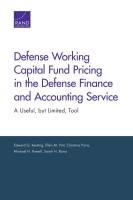| 来源类型 | Research Reports
|
| 规范类型 | 报告
|
| ISBN | 9780833088697
|
| 来源ID | RR-866-OSD
|
| Defense Working Capital Fund Pricing in the Defense Finance and Accounting Service: A Useful, but Limited, Tool |
| Edward G. Keating; Ellen M. Pint; Christina Panis; Michael H. Powell; Sarah H. Bana
|
| 发表日期 | 2015
|
| 出版年 | 2015
|
| 页码 | 64
|
| 语种 | 英语
|
| 结论 |
Advantages of DWCF Pricing for DFAS- By rewarding customers with lower prices when they switch to automated approaches, DWCF pricing encourages customers to limit their burden on DFAS.
- DWCF pricing encourages ongoing cost-related dialog both within DFAS and between DFAS and its customers.
- Being a DWCF entity provides greater managerial flexibility to DFAS than if it were solely dependent on direct appropriations. For example, it can meet increased demands without requesting additional appropriations and can continue to operate during a budget sequester.
Disadvantages of DWCF Pricing for DFAS- The DWCF structure appears to impose greater cost accounting burden than would a direct appropriation mechanism, because DFAS has to attribute its costs to specific outputs.
- DFAS customers may be developing skepticism about the actual consequences of their cost-saving steps, suspecting that DFAS simply recovers the costs in other ways.
Additional Options- An aggressive reform that would change DFAS's incentive structure considerably would be to modify DoD policy to allow other governmental or private-sector providers to compete with DFAS for DoD business.
- DoD policy could allow the services themselves to create internal, within-service competition with DFAS. However, in light of DFAS's fixed costs, the current pricing structure cannot accommodate DFAS facing such competition.
|
| 摘要 |
- A return to complete reliance on direct appropriations is probably an overreaction to DWCF pricing problems. The authors suggest, instead, that DFAS reform prices (e.g., nonlinear pricing) rather than eliminate them.
- DoD decisionmakers and DFAS customers would benefit from greater visibility into DFAS's cost structure. DFAS was unable to provide the RAND research team with information about how indirect costs were allocated and how DFAS costs were divided by customer.
- DFAS should experiment with pilot projects to better understand the implementation challenges, costs, and ultimate consequences of a nonlinear pricing approach.
|
| 主题 | Banking and Financial Services
; Military Budgets and Defense Spending
; Military Logistics
|
| URL | https://www.rand.org/pubs/research_reports/RR866.html
|
| 来源智库 | RAND Corporation (United States)
|
| 资源类型 | 智库出版物
|
| 条目标识符 | http://119.78.100.153/handle/2XGU8XDN/108097
|
推荐引用方式
GB/T 7714 |
Edward G. Keating,Ellen M. Pint,Christina Panis,et al. Defense Working Capital Fund Pricing in the Defense Finance and Accounting Service: A Useful, but Limited, Tool. 2015.
|
|
文件名:
|
x1495316342767.jpg
|
|
格式:
|
JPEG
|

|
文件名:
|
RAND_RR866.pdf
|
|
格式:
|
Adobe PDF
|
除非特别说明,本系统中所有内容都受版权保护,并保留所有权利。